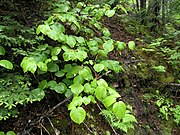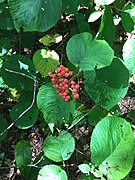Viburnum lantanoides
| Viburnum lantanoides | |
|---|---|

| |
| Scientific classification | |
| Kingdom: | Plantae |
| Clade: | Tracheophytes |
| Clade: | Angiosperms |
| Clade: | Eudicots |
| Clade: | Asterids |
| Order: | Dipsacales |
| Family: | Adoxaceae |
| Genus: | Viburnum |
| Species: | V. lantanoides |
| Binomial name | |
| Viburnum lantanoides | |
| Synonyms | |
|
V. alnifolium Marshall | |
Viburnum lantanoides (commonly known as hobble-bush,[1] witch-hobble, alder-leaved viburnum, American wayfaring tree,[2] and moosewood[3]) is a perennial shrub of the family Adoxaceae (formerly in the Caprifoliaceae), growing 2–4 meters (6–12 ft) high with pendulous branches that take root where they touch the ground. These rooted branches form obstacles which easily trip (or hobble) walkers – hence the common name.
The shrub forms large clusters of white to pink flowers in May–June. The flowers on the outer edge of the clusters are much larger (3–5 cm across). The whole cluster is typically 10 cm across. It has large, cardioid leaves which are serrate, 10–20 cm long. The bark is gray-brown and warty and the fruit is a red drupe, which turns to black when ripe.
The flowers provide nectar for the Celastrina ladon (Spring Azure) butterfly. Mammals and birds feed on its fruit, twigs, and leaves. The large showy flowers along the edge of the cluster are sterile, while the small inner flowers have both male and female parts.[4]
Distribution and habitat
Viburnum lantanoides is found in the eastern U.S. and Canada from Georgia to the Canadian Maritimes.[3] It grows in rich, moist acidic woods, stream banks, and swamps.[5]
Uses
The fruits can be eaten raw or made into jelly.[6]
Gallery
References
- ^ BSBI List 2007 (xls). Botanical Society of Britain and Ireland. Archived from the original (xls) on 2015-06-26. Retrieved 2014-10-17.
- ^ Brouillet, L., F. Coursol, S.J. Meades, M. Favreau, M. Anions, P. Bélisle & P. Desmet. 2010+. VASCAN, the Database of Vascular Plants of Canada. (consulted on 2014-07-28)
- ^ a b "Viburnum lantanoides". Germplasm Resources Information Network. Agricultural Research Service, United States Department of Agriculture. Retrieved 2018-01-02.
- ^ "Nature's Notebook: Hobblebush".
- ^ "Lady Bird Johnson Wildflower Center - The University of Texas at Austin". www.wildflower.org.
- ^ Elias, Thomas S.; Dykeman, Peter A. (2009) [1982]. Edible Wild Plants: A North American Field Guide to Over 200 Natural Foods. New York: Sterling. pp. 224, 227. ISBN 978-1-4027-6715-9. OCLC 244766414.
External links



